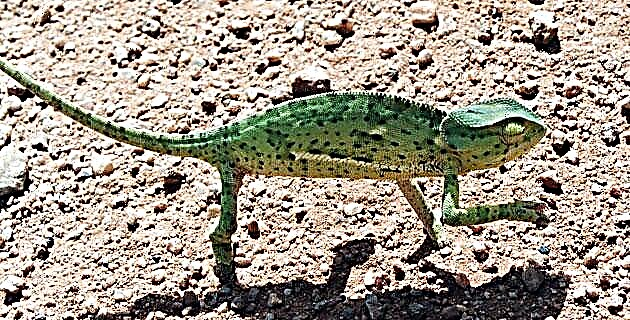
For the ancient settlers, chameleons had healing properties as they represented the spirit of the elderly.
If we could place all the species of lizards in Mexico, which are several hundred, in front of us, it would be very easy to separate the 13 species of chameleons from all of them. The characteristics of the genus Phrynosoma, which means "toad body", are a series of spines in the form of horns on the back of the head - like a kind of crown -, a chubby and somewhat flattened body, a short tail and sometimes with elongated scales on the lateral portion of the body. Some people are of the opinion that this genus looks like a miniature dinosaur.
Although these lizards have the ability to run, they do not move as much as one might think and are easy to catch with the hand. Already in our possession, the animals are docile and do not fight desperately to free themselves, nor do they bite, they simply remain comfortable in the palm of the hand. In the country these specimens receive the common name of "chameleons" and they inhabit from the south of Chiapas to the border with the United States of North America. Seven of these species are distributed in the USA and one reaches the northern part of that country and southern Canada. Throughout their distribution these animals live in dry areas, deserts, semi-desert areas, and dry mountainous areas.
Common names can easily be misused, and even confuse one animal for another; This is the case of the term “chameleon”, as it is only found in Africa, southern Europe and the Middle East. Here the use of "chameleon" is applied to a group of lizards of the Chamaeleontidae family, which can change their coloration with incredible ease in a few seconds. On the other hand, Mexican "chameleons" do not make any dramatic color change. Another example is the common name they receive in the neighboring country to the north: horny toads, or "horned toads", but it is not a toad but a reptile. Chameleons are assigned to a family of lizards scientifically called Phrynosomatidae, which includes other species that inhabit the same areas.
As is well known to most of us, lizards eat insects in general. Chameleons, for their part, have a somewhat special diet, since they eat ants, even species that bite and sting; they eat hundreds of them at the same time, frequently sitting, almost immobile in a corner or in the path of the opening of an underground anthill; they catch ants by quickly spreading their sticky tongues. This is a common feature between American and Old World chameleons. Some species also eat insects and coleopterans, although ants represent an almost inexhaustible source of food in the desert. There is a certain risk in its consumption, as there is a species of nematode that parasitizes chameleons, lives in their stomachs and can pass from one lizard to another by ingestion of ants, which are a secondary host. Often there are in lizards a large number of parasites harmless to man or any other mammal.
On the other side of the globe there is a lizard that consumes ants, very similar to the chameleon. It is the "horned demon" of Australia, which is distributed throughout the continent; Like the North American species, it is covered by scales, modified in the form of spines, it is quite slow and has a very cryptic color, but it is not completely related, but its similarity is the result of a convergent evolution. This Australian horned demon of the genus Moloch and American chameleons share one thing in common: they both use their skin to capture rainwater. Let's imagine that we are a lizard that has not had water for months. Then one day a light rain falls, but lacking implements to collect rainwater, we will be forced to watch the drops of water fall on the sand, without being able to moisten our lips. Chameleons have solved this problem: at the beginning of the rain they expand their bodies to capture the water droplets, since their skin is covered by a system of small capillary channels that extend from the margins of all the scales. The physical force of capillary action retains the water and moves it towards the edges of the jaws, from where it is ingested.
The climatic conditions of the deserts have inspired many evolutionary innovations that guarantee the survival of these species, especially in Mexico, where more than 45% of its territory presents these conditions.
For a small, slow lizard, predators that are in the air, those that crawl, or those that are simply looking for their next food, can be fatal. Undoubtedly the best defense that the chameleon has is its incredible cryptic coloration and its behavior patterns, which are reinforced with an attitude of perfect immobility when threatened. If we walk through the mountains we never see them until they move. So they run into some thicket and establish their crypticism, after which we have to re-visualize them, which can be surprisingly difficult.
However, predators do find them and sometimes manage to kill and consume them. This event depends on the skill of the hunters and the size and dexterity of the chameleon. Some recognized predators are: hawks, crows, executioners, roadrunners, pups, rattlesnakes, screechers, grasshopper mice, coyotes, and foxes. A snake that swallows a chameleon runs the risk of dying, because if it is very large, it can pierce its throat with its horns. Only very hungry snakes will take this risk. The runners can swallow all the prey, although they can also suffer some perforation. To defend themselves against a potential predator, the chameleons will flatten their back on the ground, slightly lifting one side, and in this way form a spiny flat shield, which they can move towards the attacking side of the predator. This does not always work, but if it manages to convince the predator that it is too large and too spiny to be ingested, the chameleon will manage to survive this encounter.
Some predators require more specialized defenses. If a particular coyote or fox, or similarly sized mammal, manages to capture a chameleon, they can play with it for a few minutes before its jaws grab it over the head, to deliver the final blow. At that moment the predator may receive a real surprise that will make him stop and drop the lizard from his mouth. This is due to the repulsive taste of the chameleon. This unpleasant taste is not produced by biting your flesh, but by the blood that was shot by the tear ducts located on the edges of the eyelids. The lizard's blood is strongly expelled directly into the predator's mouth. Although the lizard has wasted a valuable resource, it saved his life. Some of the chameleon's chemistry makes its blood unpleasant to predators. These, in turn, will surely learn from this experience and will never hunt another chameleon again.
Chameleons can sometimes expel blood from their eyes when lifted, this is where we have experienced this sensation. The pre-Hispanic inhabitants knew perfectly about this survival tactic, and there are legends of a “chameleon that cries blood”. Archaeologists have found ceramic representations of these from the southwest coast of Colima to the northwest of the Chihuahuan desert. Human populations in those regions had always been intrigued by chameleons.
Throughout mythology the lizards in question have been part of the cultural and biological landscape of Mexico and the United States. In some places it is believed that they have healing properties, that they represent the spirit of the elders or that they can be used to eliminate or eradicate some evil spell. We can even say that some Native Americans knew that some species do not lay eggs. This species of "viviparous" chameleons was considered an auxiliary element in childbirth.
As an integral part of a highly specialized ecosystem, chameleons are in trouble in many areas. They have lost habitat due to human activities and their growing population. Other times the causes of their disappearance are not very clear. For example, the horned toad or Texas chameleon is practically extinct in many parts of Texas, not to mention the states of Coahuila, Nuevo León and Tamaulipas, possibly due to the accidental introduction of an exotic ant by man. These aggressive ants with the common name "red fire ant" and scientific name Solenopsis invicta, have spread throughout this region for decades. Other causes that have also reduced chameleon populations are illegal collections and their medicinal use.
Chameleons are lousy pets due to their food and sunlight requirements, and they don't survive for long in captivity; on the other hand, human health problems are undoubtedly better served by modern medicine than by drying or starving these reptiles. In Mexico, a great deal of dedication to the study of the natural history of these lizards is required to know their distribution and abundance of species, so that threatened or endangered species are recognized. The continuous destruction of their habitat is certainly an obstacle to their survival. For example, the species Phrynosoma ditmarsi is known only from three locations in Sonora, and Phrynosoma cerroense is only found on the island of Cedros, in Baja California Sur. Others may be in a similar or more precarious situation, but we will never know.
The geographic location can be of great value to achieve the identification of the species in Mexico.
Of the thirteen species of chameleons that exist in Mexico, five are endemic to P. asio, P. braconnieri, P. cerroense, P. ditmarsi and P. taurus.
We Mexicans must not forget that natural resources, especially fauna, had enormous value for our ancestors, since many species were considered symbols of worship and veneration, let us remember Quetzalcóatl, the feathered serpent. In particular, peoples such as the Anasazi, Mogollones, Hohokam and Chalchihuites, left many paintings and crafts that symbolized chameleons.
Source: Unknown Mexico No. 271 / September 1999











